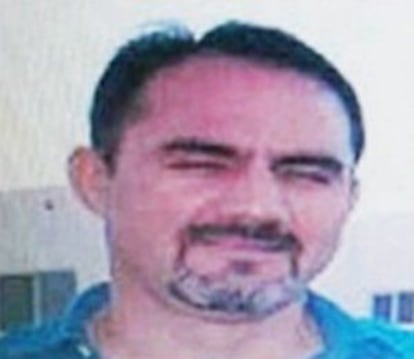Who’s heading up the Sinaloa cartel?
Dámaso “El Licenciado” López has emerged as a leader following the arrest of “El Chapo”


A picture of Mexican baseball legend Benjamín Gil hangs on the wall of a barbershop where you can get a haircut for just two dollars. The owner spends no more than five minutes on each customer, applying his clippers mercilessly to each head. Wearing cowboy boots and hats, they walk in with mops of hair and leave with military haircuts. As he clips away, he explains how things work around here. “He,” he says as he touches up some sideburns, “already knows that you are here, sitting on this sofa.” In this town called Eldorado, Dámaso “El Licenciado” López Núñez or “El Lic,” one of the heirs to imprisoned drug baron Joaquín “El Chapo” Guzmán, is invisible but occasionally pops into view. The barber points to the street, specifically to a man peering out of the window of a white van, looking around as he takes notes. Once he notices he is being observed, he starts the vehicle and disappears.
The mountain is the home of the Sinaloa cartel. Farmers have been selling their marijuana and poppy crops to the executives of this “Amazon of drugs” for decades. The organization can make any delivery, anywhere, in record time. In this rocky and hostile environment, El Chapo, who was arrested almost a year ago, amassed a fortune. El Licenciado – someone who wouldn’t be out of place on a company’s board of directors – has focused his efforts on the city on the plain: Eldorado. The town is the most populated area of the suburbs around Culiacán and is visible on the horizon because of the smoke coming out of the sugarcane mill.
El Lic helped El Chapo escape from Puente Grande prison. From that moment, he became a full-time drug dealer
El Lic was born here 48 years ago. Most of the streets are unpaved. The wind and horse-drawn carriages working as taxis raise the dust that clings to everything. El Lic’s father, Don Dámaso, was a tax collector and president of the regional livestock assembly. In 2007, he was elected trustee of Culiacán City Hall and built a bridge to connect the isolated community of Portaceli, his hometown, with the main highway. Don Dámaso died in office. He is buried in a mausoleum near the bridge – an enormous white building topped with a cross. There are security cameras on the outside of the memorial and a kitchen, air conditioning, and leather-covered seats inside. “He tried to give his kids a good education,” a family acquaintance says.
El Lic studied with the Carmelite Sisters before entering Universidad de Occidente to study law. In 1991, he got his first job as a police officer at the Sinaloa Attorney General’s Office. According to El Universal newspaper, he even directed a program to track down fugitives from the law. He was promoted through the murky world of corrupt police precincts and eventually served in the federal prison system. He held several low-level positions while earning $600 before he was appointed to a management position at the maximum security prison in Puente Grande where El Chapo was serving time after his 1993 arrest in Guatemala. Viagra, alcohol and prostitutes soon flooded the cells and with El Lic’s help, El Chapo fled in 2001. El Lic resigned from his post, citing dissatisfaction with vacation time and salary and became a full-time drug dealer.
The Drug Enforcement Administration (DEA) puts him at the top of the leadership chain within the Sinaloa cartel. In March 2012, a Virginia court accused Dámaso López of money laundering and distributing cocaine. In Eldorado he is more than just a drug dealer. He is an authority figure, imperceptible to the naked eye but present in the minds and actions of his neighbors. His men, dressed in Armani caps and Hermés vests, watch everyone who comes in and out of the area. They take down license plate numbers and share information by phone. These men used to go out into the streets on specially designated days and get trigger happy – but that tradition is now banned. Cars are no longer allowed to burn their tires and criminals are expelled from the community and sent to live in nearby towns.

“The gentleman brought a band that is very well-known in Mexico here,” an ex-municipal official recounts. “And he told all the local residents that they could go along for free. One man, a jealous bastard, tried to drag his wife out of the party by her hair. He got a pretty good beating out of it. No one ruins a party for El Lic.”
The structure of the Sinaloa cartel is a well-kept secret known only by a few members. “My impression is that the cartel has not named a successor yet,” says Javier Valdez, director of the local weekly Ríodoce. “There are several regional chiefs, such as El Chapo’s sons, El Mayo [Ismael Zambada] and El Lic. If one of them had tried to take control of everything, there would have been an internal war and there isn’t. It’s true that El Lic is a very powerful guy. He has a strong presence in the region of Eldorado with spies, vehicles that patrol the streets all day. He moves around easily here and that means he is protected.”
The only published picture of El Lic is a blurry image of a man with small eyes, a smooth forehead and a goatee taken 10 years ago. He has a son, Mini-lic, a kind of junior drug dealer who brags about his luxurious lifestyle on social media: leopards, guns, youths who have tattooed his name on their chests. Rumor had it that he might be the successor to El Chapo, his godfather. “He’s a youngster who only worries about the glamorous side,” an organized crime expert says. “He is not involved in the business. He is far from being a leader.” The narcocorridos ballads about the life of drug bosses aggrandize him but, in Sinaloa, almost no one is what they seem. After El Chapo fell, the vain capos who once wanted to be immortalized in song now ask composers to write about their rivals so the police can jump on them.
On the way to Culiacán and Eldorado, a number of memorials for victims of car accidents sit at the crossroads. One of these cement structures pays tribute to one of Lic’s sons. The young man, who crashed into a ranch, was wearing a crucifix, a gift from a relative when he died. Someone tore it off him. It had to have been a thief who thinks gold has no value on the other side. But, the next day, people woke up to find a large poster hanging from one end of a street to the other. The deceased’s father was making a public call for the crucifix to be returned. First, he used words. Then, he used lead. Since then, the townspeople say no one, not even vultures, would dare sniff the pockets of a corpse.
Translation: Dyane Jean François
Tu suscripción se está usando en otro dispositivo
¿Quieres añadir otro usuario a tu suscripción?
Si continúas leyendo en este dispositivo, no se podrá leer en el otro.
FlechaTu suscripción se está usando en otro dispositivo y solo puedes acceder a EL PAÍS desde un dispositivo a la vez.
Si quieres compartir tu cuenta, cambia tu suscripción a la modalidad Premium, así podrás añadir otro usuario. Cada uno accederá con su propia cuenta de email, lo que os permitirá personalizar vuestra experiencia en EL PAÍS.
En el caso de no saber quién está usando tu cuenta, te recomendamos cambiar tu contraseña aquí.
Si decides continuar compartiendo tu cuenta, este mensaje se mostrará en tu dispositivo y en el de la otra persona que está usando tu cuenta de forma indefinida, afectando a tu experiencia de lectura. Puedes consultar aquí los términos y condiciones de la suscripción digital.








































